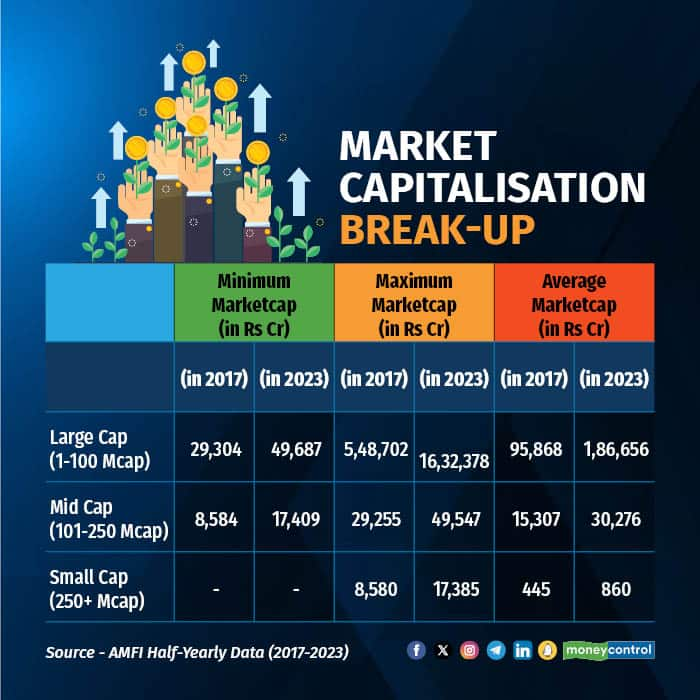
The best thing to come out of the exercise that the capital market regulator undertook in 2018 to re-categorise mutual funds was standardisation. The definition of large-cap, mid-cap and small-cap funds was standardised so that all equity funds could follow the same definition.
Advances in the equity markets have led to an increase in the market capitalisation of each of these groups of stocks. But the number of these stocks in each of these baskets has remained the same.
Perhaps the time has come for the Securities and Exchange Board of India to expand the baskets. Here’s why.
The size of the problem
As per the current rules, here’s what a large-cap, mid-cap and small-cap stocks look like:
Apart from this bucketing of stocks, there are minimum/maximum limits on allocation to stocks from different market segments for various equity fund categories.
Large and mid-cap funds need to have at least 35 percent in large-cap stocks and 35 percent in mid-cap stocks, respectively. Small-cap funds need to have at least 65 percent in small-cap stocks at all times.
Also read: Confused about which mutual funds to invest in? Check out MC30
While the definitions of large-cap, mid-cap and small-cap stocks have remained the same since 2018, the market dynamics have changed a lot as we approach 2024.

As seen in the table based on AMFI data, the minimum market capitalisation to qualify as a large-cap stock in 2017 was about Rs 29,000 crore, which has now increased to Rs 50,000 crore. The minimum market capitalisation to qualify as a mid-cap stock in 2017 was Rs 8,500 crore. That has now increased to about Rs 18,000 crore.
Expanding the basket
Given the increase of inflows in mutual funds, it is evident that many fund managers would find the current limit of 100 stocks for large-caps and 150 stocks for mid-caps restrictive. Comparatively, small-cap stocks have a larger universe beyond the 250th stock by market capitalisation.
As a result (but not only because of it), many fund managers in active large-cap funds (and now midcap funds also) find it tough to consistently beat their respective benchmarks. On the other hand, active small-cap funds still have a much bigger universe of stocks at their disposal and do much better than their benchmarks regularly.
Also read: Is investing in index funds the best way to take large-cap exposure?
Keep in mind how the Indian markets are growing and more SIP money is flowing in. We don’t want to be in a situation where we have a problem of plenty and too much money chasing a few stocks in the large and mid-cap space.
So there may be a need to provide a bigger canvas for large-cap and mid-cap fund managers to operate. And this can be done by tweaking the market-cap bucketing definitions.
Flexible boundaries
One way of fixing the problem in an emerging economy where the stock markets have more room to grow is by making these boundaries more flexible. Here’s one example.
While there is a case to have the first 150 stocks by market capitalisation (vs current 100) as large-caps and the next 250 as mid-caps (vs current 150), it might be better to set categories on the basis of percentile of market capitalisation. So, all the top stocks that make up 65 percent of market-capitalisation can be large-cap, followed by the next 25 percent as mid-caps and the remaining as small-caps.
While the definition of market capitalisation-based bucketing needs some degree of rethinking to accommodate a larger number of large-cap and mid-cap stocks, fund categorisation by itself is still good enough and provides sufficient flexibility to fund managers.
Also, the categorisation is now pretty well understood by investors since it has been in place for more than five years. So, there is no need to tinker with it and create confusion.
Only the market capitalisation-based bucketing of stocks is something that needs to be reassessed.
Check Free Credit Score on Moneycontrol: Easily track your loans, get insights, and enjoy a ₹100 cashback on your first check!